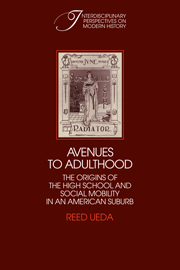Book contents
- Frontmatter
- Contents
- Acknowledgments
- Introduction
- 1 Farm village to commuter suburb
- 2 The evolution of educational leadership
- 3 The free high school
- 4 The rise of Yankee city and the prolongation of schooling
- 5 Popularizing high school: “the college of the people”
- 6 The origins of high school youth culture
- 7 Educational opportunity and social mobility
- 8 The birth of progressive reform and the junior high school
- Conclusion: The high school in the light of history
- Appendix I Courses of study
- Appendix II Sources and methods
- Appendix III Students and households
- Appendix IV Supplementary household data
- Notes
- Index
Conclusion: The high school in the light of history
Published online by Cambridge University Press: 04 August 2010
- Frontmatter
- Contents
- Acknowledgments
- Introduction
- 1 Farm village to commuter suburb
- 2 The evolution of educational leadership
- 3 The free high school
- 4 The rise of Yankee city and the prolongation of schooling
- 5 Popularizing high school: “the college of the people”
- 6 The origins of high school youth culture
- 7 Educational opportunity and social mobility
- 8 The birth of progressive reform and the junior high school
- Conclusion: The high school in the light of history
- Appendix I Courses of study
- Appendix II Sources and methods
- Appendix III Students and households
- Appendix IV Supplementary household data
- Notes
- Index
Summary
The origins of the American high school lodged in two great ramifications of the industrial revolution: the process of urban growth and the ethos to direct it through public education. The expansion of the high school sprang from the recurrent cycle of migration, social mobility, and assimilation that propelled urban growth and restructured the social relationships of wealth and power. The transformation of the high school into a multiprogram, functionalist institution at the turn of the century rested on its ability to attract a pluralistic, numerous student clientele from successive waves of newcomer families. Increasing investment in high school education stimulated and participated in a tightly woven complex of social processes – residential segregation, expansion of bureaucratic employment, voluntary and religious association, family limitation, prolonged and insulated child dependency, home ownership, and strategic intergenerational mobility – that were the behavioral components of Yankee households in the late-nineteenth-century suburb. In this way, high school attendance facilitated and reflected the formation of a Yankee middle class emerging out of these interconnected social changes in this period. Conversely, it helped to articulate the behavioral and strategic dimensions of lower-class experience by excluding families without the prerequisite components for sponsorship of secondary schooling.
The opportunity for a high school education was apportioned according to the structure of social and economic inequality in industrial society. The chances for youths to gain secondary schooling remained directly related to the household's capacity to accumulate and invest resources in them. The Yankee middle class capitalized more than any other social group on high school training. High school students from immigrant and workingmen's families had an edge over grammar dropouts.
- Type
- Chapter
- Information
- Avenues to AdulthoodThe Origins of the High School and Social Mobility in an American Suburb, pp. 220 - 224Publisher: Cambridge University PressPrint publication year: 1987



